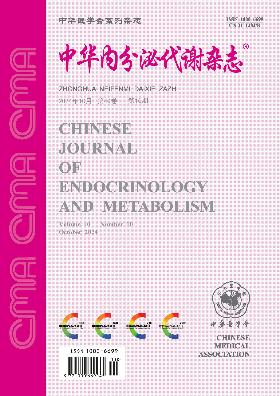肢端肥大症患者循环骨源性激素骨钙素、脂运载蛋白2与葡萄糖代谢的关系
Q4 Medicine
引用次数: 0
摘要
目的探讨活动性肢端肥大症患者血清骨源性激素骨钙素和脂钙素2 (LCN2)水平的变化,并进一步探讨骨钙素和LCN2在糖代谢中的潜在作用。方法选取2016年12月至2018年8月南京鼓楼医院确诊为肢端肥大症的患者50例。其中41例术后随访资料完整的患者也纳入了研究。性别、年龄和体重指数与健康人相匹配,作为正常对照。比较对照组和肢端肥大症患者以及术前和术后血清骨钙素和LCN2水平。采用单因素和多因素线性回归分析探讨骨源性激素与糖代谢指标之间的相关性,并确定变量之间的独立相关性。结果与正常对照组相比,血清骨钙素升高(55.45±34.02 vs 19.46±6.69)ng/ml, P < 0.05)。术后随着血清生长激素(GH)和胰岛素样生长因子1(IGF-1)的降低,血清骨钙素水平较术前显著降低[24.79(18.39,32.59)比43.51(26.73,65.66)ng/ml, P<0.01], LCN2水平显著升高[(45.15±15.33)比37.03±9.73)ng/ml, P<0.05]。在多元线性逐步回归分析中,瘦体重是LCN2的唯一阳性预测因子(β=0.44, P=0.015),血清IGF-1升高是骨钙素的阳性预测因子(β=0.512, P<0.01)。在多变量模型中,低LCN2 (β=-0.398, P=0.017)和血清骨钙素升高(β=0.553, P=0.001)是AUCINS的预测因子,骨钙素是HOMA- β的阳性预测因子(β=0.519, P=0.004)。在肢端肥大症患者的多变量检测中,GH (β=0.294, P=0.029)和IGF-1(β = 0.428, P=0.002)均被确定为HOMA-IR的阳性预测因子。结论肢端肥大症患者血清骨钙素升高,LCN2水平降低,纠正生化异常后可发现相应的改变。血清骨钙素和LCN2是肢端肥大症患者β细胞功能的预测指标。本研究为骨在肢端肥大症中调节糖代谢的作用提供了新的证据。关键词:肢端肥大症;骨钙素;Lipocalin 2;葡萄糖代谢本文章由计算机程序翻译,如有差异,请以英文原文为准。
Associations between circulating bone-derived hormones osteocalcin, lipocalin 2, and glucose metabolism in patients with acromegaly
Objective
The aim of this study was to examine the change of serum bone-derived hormones osteocalcin and lipocalin 2 (LCN2) level in patients with active acromegaly, and to further investigate the potential role of osteocalcin and LCN2 in glucose metabolism.
Methods
Fifty consecutive patients diagnosed as acromegaly in Nanjing Drum Tower Hospital from December 2016 to August 2018 were recruited. Of those, 41 patients after operations with complete follow-up data were also included. 30 sex, age, and body mass index matched healthy persons as normal controls. Serum osteocalcin and LCN2 levels were compared between controls and patients with acromegaly, as well as at pre- and post- operation periods. Univariate and multivariate linear regression analyses were used to investigate the correlation between bone-derived hormones and glucose metabolism indexes and to determine the independent associations between variables.
Results
Compared with normal controls, serum osteocalcin increased [(55.45±34.02 vs 19.46±6.69)ng/ml, P 0.05). After operation, with the decrease of serum growth hormone (GH) and insulin-like growth factor 1 (IGF-1), serum osteocalcin level decreased [24.79(18.39, 32.59) vs 43.51(26.73, 65.66)ng/ml, P<0.01] and LCN2 level increased [(45.15±15.33 vs 37.03±9.73)ng/ml, P<0.05] significantly compare to pre-operation levels. In a multivariate linear stepwise regression analysis, lean mass was shown to be the only positive predictor for LCN2 (β=0.44, P=0.015) and elevated serum IGF-1 was a positive predictor for osteocalcin (β=0.512, P<0.01). In the multivariate models, low LCN2 (β=-0.398, P=0.017) and elevated serum osteocalcin (β=0.553, P=0.001) were predictors for AUCINS, osteocalcin was a positive predictor of HOMA- β (β=0.519, P=0.004). GH (β=0.294, P=0.029) and IGF-1(β = 0.428, P=0.002) were all identified as positive predictors of HOMA-IR during multivariate testing in acromegaly patients.
Conclusions
Acromegaly patients had increased osteocalcin and decreased LCN2 serum levels, and corresponding alteration was detected with the correction of biochemical abnormalities. Serum osteocalcin and LCN2 were predictors of β-cell function in acromegaly patients. This study adds new evidence for the role of bone in regulating glucose metabolism in acromegaly.
Key words:
Acromegaly; Osteocalcin; Lipocalin 2; Glucose metabolism
求助全文
通过发布文献求助,成功后即可免费获取论文全文。
去求助
来源期刊

中华内分泌代谢杂志
Medicine-Endocrinology, Diabetes and Metabolism
CiteScore
0.60
自引率
0.00%
发文量
7243
期刊介绍:
The Chinese Journal of Endocrinology and Metabolism was founded in July 1985. It is a senior academic journal in the field of endocrinology and metabolism sponsored by the Chinese Medical Association. The journal aims to be the "Chinese broadcaster of new knowledge on endocrinology and metabolism worldwide". It reports leading scientific research results and clinical diagnosis and treatment experience in endocrinology and metabolism and related fields, as well as basic theoretical research that has a guiding role in endocrinology and metabolism clinics and is closely integrated with clinics. The journal is a core journal of Chinese science and technology (a statistical source journal of Chinese science and technology papers), and is included in Chinese and foreign statistical source journal databases such as the Chinese Science and Technology Papers and Citation Database, Chemical Abstracts, and Scopus.
 求助内容:
求助内容: 应助结果提醒方式:
应助结果提醒方式:


